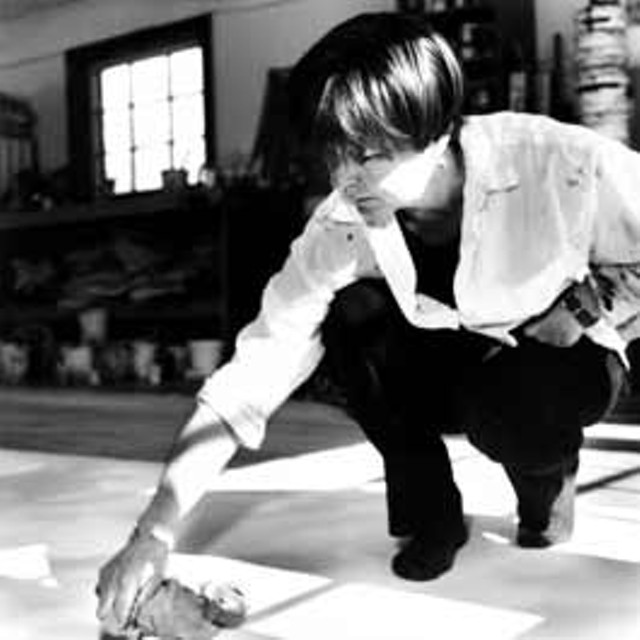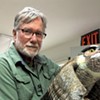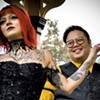Published March 28, 2001 at 8:18 p.m.
Adelaide Murphy Tyrol has an eye for things most people never notice. When the Plainfield artist isn’t painting room-sized backdrops designed to disappear behind larger-than-life subjects such as Bruce Springsteen or the Dalai Lama, she’s rendering anatomically correct images of obscure insects, many of which can only be seen through a high-powered microscope. Tyrol pursues her split-screen passions in a two-story studio beside the house she shares with her husband, Brian Tyrol, and their two children on 20-plus sweeping acres on Hollister Hill.
The silent, wide-open setting seems a long way from the slick, cosmopolitan world of Richard Avedon, Mary Ellen Mark and the other top-name photographers who commission Tyrol’s backdrops. It’s also a far cry from the extreme close-ups of biological subjects — bugs, birds and other organisms — she shows at the Richardson-Clarke Gallery on Newbury Street in Boston, at the Fairbanks Museum and, last summer, at the Vermont Supreme Court.
The day I visit her, the sky is a relentless, nearly cloudless blue, and the unbroken expanse between the studio and the distant mountains is a clean canvas of wind-swept snow. Tyrol, 46, wears black stretch pants and an oversized man’s shirt, both generously smeared with paint. A pair of clogs allows her to step into her stocking feet so she can walk with impunity across the enormous canvas stretched over the downstairs floor. Rock ’n’ roll blares from a boom box. A swing hangs from the ceiling — inducement for Tyrol’s kids, now 7 and 11, to keep out of trouble while Mom is working. Gallon-sized paint cans, with a rainbow of wooden paddles poking out of their tops, line a floor that’s as busy as a Jackson Pollock canvas — a testament to its long service as the artist’s palette.
Tyrol set up her Plainfield studio 13 years ago. The daughter of a Holyoke, Massachusetts, newspaper family, she studied English and art at the University of Vermont, then moved to New York for courses in illustration at the Parsons School of Design and in fine arts at the Art Students League. In 1980, she began working for Sarah Oliphant, a theater artist who had opened a backdrop-painting business two years earlier. It didn’t take Tyrol long to graduate from washing buckets at Oliphant Studios to becoming a full partner in the company.
Besides creating backdrops for sale, Oliphant offers clients the more affordable option of renting ready-to-hang images from the studio’s enormous inventory. The company catalogue features a seemingly limitless variety of skies — stormy, blue, rainbow, daytime, nighttime, surrealistic or “airplane” — as well as landscapes, snowscapes, cityscapes, seascapes, interiors, abstract mottled surfaces and gradations. There are also take-offs on famous artists, from Vincent Van Gogh to Maxfield Parrish, and — for a recent Rolling Stone cover of Jennifer Lopez — fantasy artist Frank Franzetta.
Though most of Oliphant’s oeuvre appears in magazines, the studio’s work has also adorned fashion runways, been used on TV shows like “Saturday Night Live” and “The Chris Rock Show,” and become permanent installations at locations including the FAO Schwartz toy store in Manhattan and JFK Airport. At JFK, Tyrol and two other artists airbrushed 14,000 feet of sky inside the International Arrivals Building. The job took 10 days, from 11 at night until six in the morning; the work surface was so enormous that the painters could hardly see one another. “We should have had roller skates,” Tyrol quips.
Adelaide Murphy Tyrol moved to Plainfield after marrying a Vermonter, Brian Tyrol. Their courtship took place over a batch of ball-and-claw bathtubs. He was working for Great American Salvage, which ran a New York City showroom next door to Oliphant. She was hired to paint skies and underwater scenes on the sides of the tubs. “It didn’t go anywhere, except that we got married,” Tyrol says of the painted tub venture. Today, Brian heads CadCut, a Montpelier company specializing in computer-assisted slicing of aerospace and medical parts; Adelaide maintains Oliphant Studio’s Web site, designs its catalogue, prices jobs and paints her share of backdrops.
Here in Vermont, Tyrol has produced a number of stage backdrops for the Unadilla Theatre in Calais. Her handiwork can also be seen on the walls and ceilings of several local restaurants and stores, and in the Twinfield Union Schools. Several years ago, she painted an entire wing of the Union elementary schools. This year, Tyrol created a deep-sea mural in the high school, complete with sea turtles, giant jellyfish, octopus and underwater plants.
Though her formal training is in small-format drawing, Tyrol found that the switch to painting on a massive canvas wasn’t such a, well, stretch. Doing big art, she says, just requires enough space and “a certain kind of bravado.” When she paints a backdrop, Tyrol begins by laying the canvas across the studio floor. Then she treats its surface with gesso sizing, first pouring it on with a watering can and then spreading it around with a push broom. After the gesso dries, she “cartoons out” her image, using a fat stick of charcoal taped to the end of a bamboo pole. “You have to stand back and squint,” she explains. “It’s almost as if your shoulder is your wrist.”
When she needs to erase a mistake, Tyrol simply beats at the canvas with a rag, and the charcoal lifts right off. Next, she deploys a compressor air gun with 40 pounds of pressure to lay down her base colors. Details are quickly filled in with a two-inch brush taped to another bamboo pole. Tyrol uses water-based acrylics, which dry quickly and remain elastic, allowing her to easily roll the completed canvas around a carpet tube, slide it into a plastic sewer pipe and ship it off to the client. “This is really old-fashioned, painting on canvas,” Tyrol comments.
This fact came home to Oliphant in the mid-1990s, when digitized graphics took a big bite out of the backdrop business. Why hire someone to paint faux foliage when you can simulate the rainforest from the comfort of your own computer? For a few bad years, Tyrol says, “Everyone was a designer. It really showed on magazine covers. I think they looked really shitty.”
Though most up-and-coming photographers still use Photo-Shop and other software to marry images, she’s relieved to note that the trend is beginning to reverse itself, with top-of-the-line photographers like Annie Leibowitz and Michael O’Neill continuing to work with painters. Meanwhile, Oliphant has hedged its marketing bets by taking on more architectural jobs, such as the one at JFK.
While her company has had to adapt to technological change, Tyrol has also been forced to adjust from the gregarious, coffee-swilling excitement of working in a five-person studio in the heart of Manhattan’s photography district to the relentless peace and quiet of rural Vermont. “I went from being part of a team working together to echoing pine trees,” she muses.
To combat the loneliness of the long-distance artist, Tyrol hosts a weekly drawing group at her studio. And she periodically escapes the solitude of her isolated studio to sketch specimens on location. Two years ago, she explored the stuffed-bird collection at the Fairbanks Museum in St. Johnsbury. These days, she spends a couple mornings a month at the Forest Biology Lab in Waterbury, visiting and drawing bugs in the custody of state entomologist Trish Hanson.
Tyrol met Hanson through natural history illustration, a sideline the artist has been pursuing since 1976. Though she has little formal training in science, Tyrol has always been interested in plants and animals, she says. To date, her work has appeared in 15 to 20 books, and has graced numerous magazine articles. When Northern Woodlands magazine asked her to illustrate a terpentine beetle and Tyrol couldn’t find the creature in any of her field guides, a friend steered her to Hanson, who’d just written a paper on the species.
In addition to terpentine beetles, the enthusiastic entomologist invited Tyrol to check out other species, and encouraged her to take a closer look through the lab’s high-powered microscope. The artist has been bug-eyed ever since. “Once you start seeing what you can see through the microscope,” she observes, “it’s pretty hard to go back to the magnifying glass.” Hanson “just opened up a world for me,” she adds. “It’s a world I was always interested in, but she’s given me the guts to go in a little further.”
When she browses through the drawers full of specimens in Hanson’s lab, Tyrol doesn’t care much about the insects’ origins or their interaction with the environment. She only has eyes for the aesthetic appeal of the bugs’ little six-legged bodies. It might be the spreading wings of a wasp that catch her attention, or a bend in a stick-bug’s leg.
She turns her sketches into paintings in the upstairs portion of her studio. Here, the soundtrack is quiet and classical. Shelves are lined with art books, field guides and National Geographics. A dish holds a handful of stones and a single seashell. A large bone sits on one surface, a stuffed quail on another, and a pile of insect specimens on a third. A pair of binoculars waits on the window sill beside the drawing table. Tyrol’s paintings lovingly portray the often off-putting minutia of entomological anatomy, down to the eight eyes on the face of a furry spider and the mitten-shaped doodads on a gold bug’s antennae.
But her images, usually just a little larger than your average picture book, are neither fussy nor stiff. Muscular, expressive and rendered in deep, lusty colors, her bugs seem to dare you to swat them. Since she began with Oliphant, Tyrol’s bug backgrounds have evolved from relatively flat planes to solid-seeming spaces that catch the viewer’s eye with their corrosive surfaces — an effect she achieves by combining water-based gouache with oil-stick crayons. “They don’t like each other,” she explains. “So it creates this friction.”
Balancing the large-scale dash of big commercial backdrops and close-ups of tiny species, however, doesn’t create any similar friction for Tyrol as an artist. “They’re not as disparate as they seem,” she says. “These things that seem so opposite create a whole life for me, somehow.”
Adelaide Murphy Tyrol will exhibit her art in May at the Blinking Light Gallery in Plainfield.
More By This Author
Speaking of Art, artist Interview
-

Q&A: Catching Up With the Champlain Valley Quilt Guild
Apr 10, 2024 -

Video: The Champlain Valley Quilt Guild Prepares for Its Biennial Quilt Show
Apr 4, 2024 -

Q&A: Meet a Family in Waterbury That Embraces Halloween Year-Round
Feb 14, 2024 -

Video: Goth Family in Waterbury: Sarah, Jay and Zarek Vogelsang-Card
Feb 8, 2024 -

Q&A: Art Entrepreneurs Tessa and Torrey Valyou Celebrate 15 Years of New Duds
Oct 11, 2023 - More »
Comments
Comments are closed.
From 2014-2020, Seven Days allowed readers to comment on all stories posted on our website. While we've appreciated the suggestions and insights, right now Seven Days is prioritizing our core mission — producing high-quality, responsible local journalism — over moderating online debates between readers.
To criticize, correct or praise our reporting, please send us a letter to the editor or send us a tip. We’ll check it out and report the results.
Online comments may return when we have better tech tools for managing them. Thanks for reading.












































